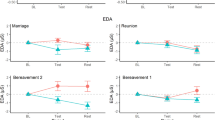Abstract
Theories of emotional weeping indicate that expression through tears is healthy, but laboratory research has produced mixed results. Fifty women viewed a sad videotape under instructions to either express or inhibit crying. Mood and stress levels were measured before and after viewing, and skin conductance was monitored continuously. Subjects also reported their crying frequency in the past month. A median split on crying intensity divided subjects into two groups; subjects included in analyses were those in the expression condition who reported strong reactions, and those in the inhibition condition who did not. Thirty-five participants fit these categories. The results indicated that moods became more negative from pre- to postmovie for both groups. Skin conductance, or arousal level, was higher at the end of the movie in the inhibition than in the expression condition. On the stress measure, condition and natural crying propensity interacted, so that subjects with the highest stress levels were those whose behavior in the study was inconsistent with their natural tendencies. The results are discussed in the context of earlier research on behavioral inhibition and emotional regulation.
Similar content being viewed by others
References
Bohlin, G., & Kjellberg, A. (1973). Self-reported arousal during sleep deprivation and its relation to performance and physiological variables.Scandinavian Journal of Psychology, 14, 78–86.
Breuer, J., & Freud, S. (1955).Studies on hysteria (J. Strachey, Trans.). London: The Hogarth Press. (Original work published 1895)
Buck, R., Miller, R. E., & Caul, W. F. (1974). Sex, personality, and physiological variables in the communication of affect via facial expression.Journal of Personality and Social Psychology, 30, 587–596.
Crepeau, M. T. (1980).A Comparison of the Behavior Patterns and Meanings of Weeping Among Adult Men and Women Across Three Health Conditions. Unpublished doctoral dissertation, University of Pittsburgh.
Efran, J. J., & Spangler, T. T. (1979). Why grown-ups cry: A two-factor theory and evidence from The Miracle Worker.Motivation and Emotion, 33, 63–72.
Frey, W. H., Hoffman-Ahern, C., Johnson, R. A., Lykken, D. T., & Tuason, V. B. (1983). Crying behavior in the human adult.Integrative Psychiatry, 1, 94–100.
Frey, W. H., & Langseth, M. (1985).Crying: The mystery of tears. San Francisco: Harper & Row.
Friedman, M., & Rosenman, R. H. (1959). Association of specific overt behavior pattern with blood and cardiovascular findings.Journal of the American Medical Association, 169, 1286–1296.
Gross, J. (1989). Emotional expression in cancer onset and progression.Social Science and Medicine, 12, 1239–1248.
Gross, J. J., Fredrickson, B. L., & Levenson, R. W. (1994). The psychophysiology of crying.Psychophysiology, 31, 460–468.
Gross, J. J., & Levenson, R. W. (1993). Emotional suppression: Physiology, self-report, and expressive behavior.Journal of Personality and Social Psychology, 64, 970–986.
Gross, J. J., & Munoz, R. F. (1995). Emotional regulation and mental health.Clinical Psychology: Science and Practice, 2, 151–164.
Hastrup, J. L., Baker, J. G., Kraemer, D. L., & Bornstein, R. F. (1986). Crying and depression among older adults.Gerontologist, 26, 91–96.
Kjellberg, A., & Bohlin, G. (1974). Self-reported arousal: Further development of a multifactorial inventory.Scandinavian Journal of Psychology, 15, 285–292.
Knapp, D., Berman, L. S. (producers), & Kleiser, R. (Director). (1981)Peege [Film]. New Brunswick, NJ: Phoenix Films.
Koestler, A. (1964).The act of creation. New York: The Macmillan Co.
Kraemer, D. L., & Hastrup, J. L. (1988). Crying in adults: Self-control and autonomic correlates.Journal of Social and Clinical Psychology, 6, 53–68.
Labott, S. M., Ahleman, S., Wolever, M. E., & Martin, R. B. (1990). The physiological and psychological effects of the expression and inhibition of emotion.Behavioral Medicine, 16, 182–189.
Labott, S. M., & Martin, R. B. (1987). The stress-moderating effects of weeping and humor.Journal of Human Stress, 13, 159–164.
Labott, S. M., & Martin, R. B. (1988). Weeping: Evidence for a cognitive theory.Motivation and Emotion, 12, 205–216.
Labott, S. M., & Martin, R. B. (1990). Emotional coping, age, and physical disorder.Behavioral Medicine, 16, 53–61.
Labott, S. M., Martin, R. B., Eason, P. S., & Berkey, E. Y. (1991). Social reactions to the expression of emotion.Cognition and Emotion, 5, 397–417.
Martin, R. B., & Labott, S. M. (1991). Mood following emotional crying: Effects of the situation.Journal of Research in Personality, 25, 218–244.
Pennebaker, J. W., & Chew, C. H. (1985). Behavioral inhibition and electrodermal activity during deception.Journal of Personality and Social Psychology, 49, 1427–1433.
Pennebaker, J. W., Hughes, C. F., & O'Heeron, R. C. (1987). The psychophysiology of confession: Linking inhibitory and psychosomatic processes.Journal of Personality and Social Psychology, 52, 781–793.
Plas, J. M., & Hoover-Dempsey, K. V. (1988).Working up a storm. New York: W. W. Norton.
Ross, C. E., & Mirowsky, J. (1984). Men who cry.Social Psychology Quarterly, 47, 138–146.
Shacham, S. (1983). A shortened version of the Profile of Mood States.Journal of Personality Assessment, 47, 305–306.
Smith, T. W. (1992). Hostility and health: Current status of a psychosomatic hypothesis.Health Psychology, 11, 139–150.
Williams, D. G. (1982). Weeping by adults: Personality correlates and sex differences.The Journal of Psychology, 110, 217–226.
Author information
Authors and Affiliations
Additional information
Supported by a Small Research Grant to the first author.
Rights and permissions
About this article
Cite this article
Labott, S.M., Teleha, M.K. Weeping propensity and the effects of laboratory expression or inhibition. Motiv Emot 20, 273–284 (1996). https://doi.org/10.1007/BF02251890
Issue Date:
DOI: https://doi.org/10.1007/BF02251890




